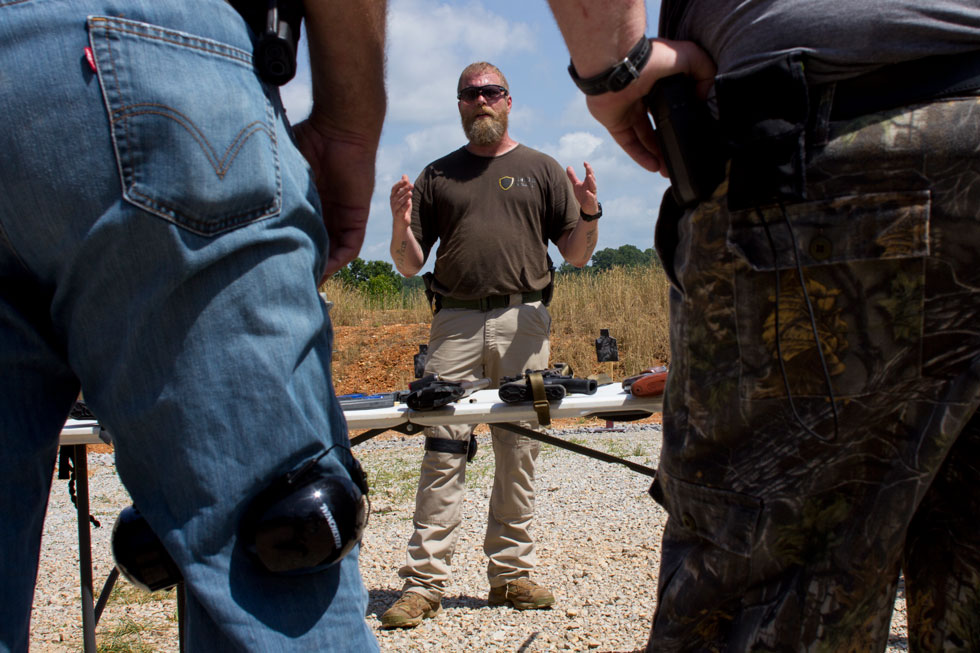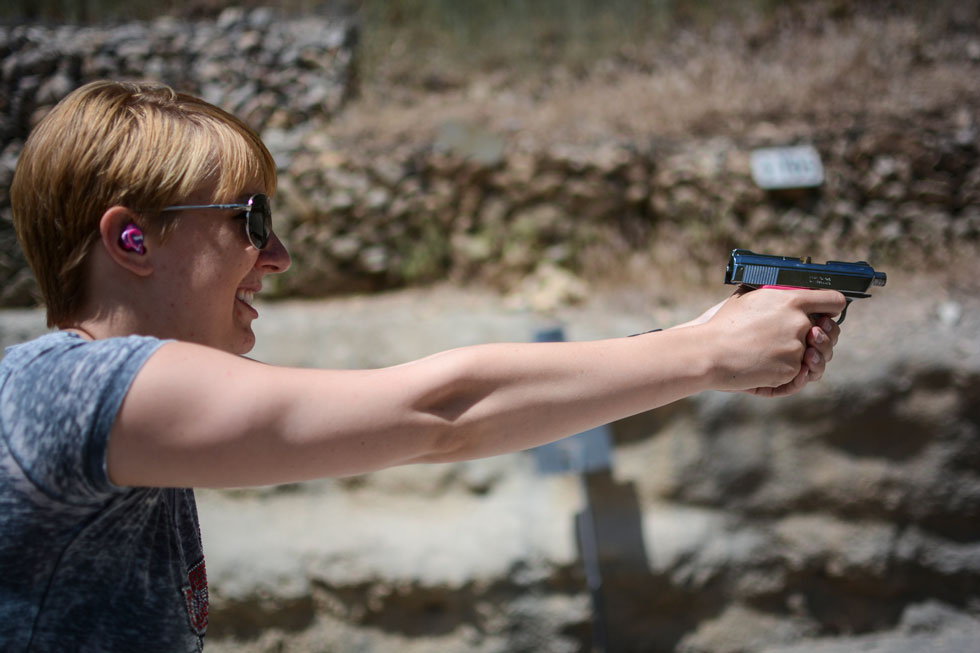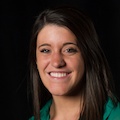Teachers training to be ready when intruder attacks their school
The heavy, rhythmic stomp of combat boots creates a chilling sound through the dark hallway. “Get me the principal,” the gunman shouts, his command echoing through the school.
A team of teachers scans the area with their guns extended and eyes alert. They locate the shooter and race down the tiled floor to meet the armed intruder before he shoots, but he lifts his weapon and fires.
The shooter is a certified safety trainer with SWAT-team experience, and his bullets are blank. Once the trainer fires, the drill begins again for the teachers training in pairs. Today, Fairview School in West Plains is mostly empty for summer break, as eight teachers train for an emergency situation here.
“We take people who have never picked up a firearm before and we train them,” said Greg Martin, CEO of Shield Solutions. “When we’re done with them, they’re better than most of our law enforcement.”
Martin, who was in law enforcement for more than a decade, created Shield Solutions as a separate branch of his security and investigations company after the 2012 shootings at Sandy Hook Elementary School in Newtown, Connecticut.
Teachers from 10 different schools in Missouri have trained with Shield Solutions. It is the only training course approved by the Missouri United School Insurance Council (MUSIC), which provides insurance for about 87 percent of school districts in the state.
“Once they go through the training and they qualify, then they are essentially an employee of Shield Solutions,” Martin said. “I provide workman’s comp insurance and liability insurance for them.”
Martin’s liability insurance takes the pressure off of MUSIC should an emergency happen.
Schools can seek out the training
School administrators that want to have teachers trained as protection officers send two team members to train. The training costs $17,500 for the pair. In order to be eligible, the teachers must obtain a concealed-carry permit, pass a drug test and undergo psychiatric evaluation. Once they make it to the course, they must also pass an initial shooting qualification by firing at targets up to 25 yards away with 90 percent accuracy. A teacher who cannot pass this qualification is dropped from the program.
“We do that because it simulates them having to be in a gunfight and how effective, how accurate, they’re going to be in that gun fight,” said Don Crowley, the training coordinator for Shield Solutions. “We don’t allow them warm-up rounds.”
The first step in the teacher training program is completing a 40-hour training course over a five-day period. During this initial training teachers learn fundamental firearm safety rules and basic techniques of marksmanship, and they practice firing on the range. To maintain their protection-officer status, the teachers have to complete 24 additional hours of training every year: Three eight-hour courses, in the spring, summer and fall.
“This is a military, law-enforcement-style training,” said Martin. “At the end of the 40 hours they are a whole different person. They understand that the weapon is a tool for them, it’s not just a firearm.”
On the range, the teachers become students. The Shield Solutions training team stands nearby, dressed in combat boots and Army green T-shirts that identify them as instructors. The sun and humidity on the range is so oppressive that even the bugs prefer to stay in the shade.
Everyone wears ear and eye protection and the teachers-turned-students fire at tin targets across the gravel-covered ground. As they begin to shoot, the teachers pull a neon yellow sash out of their belts and throw them around their necks that would identify themselves as “good guys” to law enforcement.
Missouri Gun Training for Teachers
The loud pings of bullets hitting metal echoes through the surrounding Ozark Mountains and the occasional cloud of dust rises from the dirt behind the target if the shooter is offline. Missing is not something the instructors take lightly. The teachers-in-training pay for bad shots with push-ups or sprints.
After the range training, the teachers and trainers head to the local elementary school to practice “shoot/don’t shoot” scenarios.

Training supervisor Don Crowley stands over a table of rifles at the Shield Solutions gun range in West Plains, Mo. Teachers may encounter these "battlefield pick-up" weapons confronting an active school shooter. The company trains Missouri district employees gun etiquette and tactical response. Photo by Erin Patrick O’Connor/News21.
Fairview was the first
Fairview School, a K-8 school of around 500 students, was the first school to use school-protection officers trained by Shield Solutions. Located in rural West Plains, 113 miles from Springfield, the school wanted a faster response time in the event of an active-shooter situation.
“The police station isn’t sitting across the street,” said Principal Aaron Sydow, who approached Martin about starting the program. Sydow had used Martin’s services in the past and asked him to create a teacher-training course after the shootings at Sandy Hook.
“We have had a lot of conversations with the sheriff’s department who would be responding, the Howell County Sheriff’s department,” Sydow said. “Their best case scenario would be eight minutes.”
The school board for West Plains school district approved concealed-carry for certified teachers in February 2013, and the first teachers graduated from the training program that March. Although Missouri state law prohibits firearms in school buildings, an exception lets schools arm teachers with school board approval.
Names of the armed teachers are confidential. Teachers, students and parents are all unaware of who is carrying. Only the principal and school superintendent know.
Each school with school-protection officers proudly boasts Shield Solutions stickers on every entrance to inform the public that their school has teachers trained in gun use.
“It is our God’s honest wish that they never have to implement this training; that the occasion for this training to be employed never arises,” Crowley said. “However, we think that it’s important for them to have this training, should they choose to attend, to level the playing field.”
Training in Utah
A Weber County School District teacher stands at the front of a classroom filled with 15 other school employees sitting at desks and acting as students. The Utah teacher glances out the window at a mock-up of a school building that sits at the base of the snow-capped Wasatch Mountain Range.
An alarm sounds over the intercom. The teacher and “students” prepare for a lockdown. They turn out the lights and hide behind desks, filing cabinets, and each other, but a gunman enters the classroom before it’s locked. A senior SWAT member playing the gunman prepares to open fire.
The teacher, with a loaded “Simunitions” weapon in hand, reacts based on learned technique not just instinct. With every pull of the trigger, a Toxfree primer cartridge rips out of the barrel, aimed at the approaching gunman. Each point of impact is stained, similar to a paintball’s imprint. It allows for an assessment of the shot’s lethality.
This is the final phase of a training program at the Swanson Tactical Training Center through the Weber County Sheriff’s Department in Ogden, Utah. It is a close imitation of a real-life active-shooter scenario.
“We intended to give them basic training in how to protect themselves and students,” said Weber County Lt. Jeff Pledger, who has been conducting firearms training for more than 10 years. “It’s designed for anyone employed in the school district who comes in contact with students and might feel a responsibility to protect those students.”
The program is run over a 28-hour period with seven training classes that last four hours each. The first day covers what an active shooter situation entails through the use of case studies. The next sessions include a concealed-weapons permit course, emergency life-saving medical treatment training by a physician and firearms training. Then the students and instructors head out to the shooting range, where they complete eight hours of live fire work with specific training in defensive use of the handgun and close-quarter situations.
On the final day, they go to a simunitions village and the students get active-shooter simulations in mock classrooms, hallways and cafeterias.
“They are all getting part of the learning benefit out of seeing what was going on and the critiques that we do after each scenario is run,” Pledger said. “One is realism in terms of innocent people around in the room. They know they are responsible for each round that they fire.”
With school shootings seemingly constantly in the news, other non-government training has become available for Utah educators.
“We’re not saying that having a firearm in a classroom and if a teacher would engage, that it’s absolutely going to save a certain number of lives,” said Clark Aposhian, chairman of the Utah Sports Shooting Council. “But we do know with absolute certainty the exact number of our sweet innocent little children and our dedicated teaching professionals who lost their lives in these school shootings when no one was allowed to carry a firearm.”
Most public schools run students and faculty through lockdown drills that are dictated by the district as preparation for active-shooter situations. A lockdown typically consists of a teacher getting everyone into a classroom and locking the door with their kids inside, then turning off the lights and gathering all the kids into a corner, a coat room or behind a shelf, somewhere they can’t be seen from the window or the door. The teacher shields the kids and doesn’t open the door until the police have arrived and identified themselves.
“They do not envision, in these lockdown drills, the shooter penetrating that door, they don’t tell them what to do,” Aposhian said. “Our plan picks up where theirs leaves off.”
Since Sandy Hook, more than 500 school employees have gone through the training, most of whom are teachers.

Kasey Hansen fires at a target at a shooting range outside Salt Lake City. Clark Aposhian, a firearms safety instructor, supervises her technique and offers guidance on gun safety. Photo by Jacob Byk/News21.
She and more than 200 other school employees took the Sports Council’s first training course after Sandy Hook.
“I’d never had any formal training before,” Hansen said, “so that was the first time I actually got to know the parts of a gun, how to use the gun, how to properly store a gun and safety.”
In the course, teachers learn the difference between cover, which hides a person, and conceal, which stops a bullet. They go over commands, line of fire, and discuss unintended targets, the result of missed shots, for example. The focus is on self-defense, not engagement.
“For the school teachers, we’ve created a special module that envisions them on a school bus or in a classroom or in a lunch room, including out in the parking lot,” said Aposhian. “They need to be aware of the use of firearms in an environment where there’s people that could get hurt or injured or killed by the use of their weapon.”
Despite the training and added sense of security, preparation doesn’t take away the potential horror of the situation.
“Even though I do have a gun I’m terrified,” Hansen said. “… but I feel confident that I can act accordingly if it happens.”
If there was a shooter in the school, Hansen said she would feel responsible for everyone and that she had to take action.
“I would grab the students and pull them in the classroom, and we would find somewhere to hide them,” Hansen said. “I would stay in front of them and have my gun out, ready to go in case someone barges through the door.”







